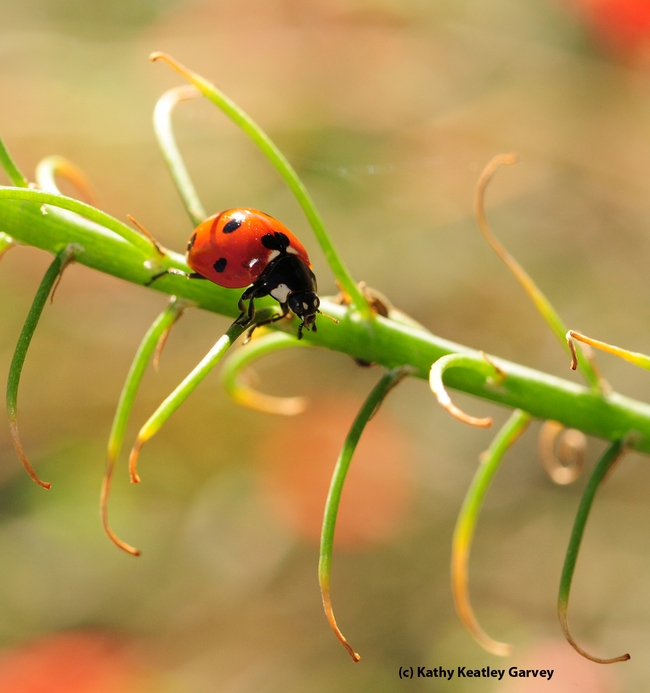- Author: Kathy Keatley Garvey
Mark your calendars!
The next open house at the Bohart Museum of Entomology, located in Room 1124 of the Academic Surge Building on Crocker Lane, UC Davis campus, is set for 1 to 4 p.m., Sunday, Nov. 18. It's free and family friendly.
"The focus is urban entomology," said director Lynn Kimsey, UC Davis professor of entomology. "We'll have out examples of all the wonderful household pests/friends and garden pests, along with the kinds of things they inspect restaurants for."
Think of such beneficial insects in the garden as lady beetles (lady bugs) and praying mantids, and such pests as cockroaches and booklice in homes and restaurants.
What are booklice? These nearly microscopic insects, Liposcelis bostrychophila, or "psocids" (pronounced "so kids"), are common pests in stored grains. They're usually unseen because they're about a millimeter long--about the size of a speck of dust--and are transparent to light brown in color.
At the open house, look for scores of displays dealing with urban entomology. The UC Statewide Integrated Pest Management Program (UC IPM) will take part. A family arts and crafts activity is also planned.
The Bohart Museum, home of nearly eight million insect specimens, is the seventh largest insect collection in North America and houses the California Insect Survey, a storehouse of insect biodiversity.
In addition, the Bohart features a live "petting zoo," comprised of Madagascar hissing cockroaches, walking sticks, tarantulas and praying mantids; and a year-around gift shop, which is stocked with T-shirts, sweatshirts, books, jewelry, posters, insect-collecting equipment and insect-themed candy.
Public weekend hours for the academic year 2018-2019 are:
- Sunday, Nov. 18, from 1 to 4 p.m.: "Bring It Home: Urban Entomology"
- Saturday, Jan. 12, from 1 to 4 p.m.: "Time's Fun When You're Studying Flies"
- Saturday, Feb. 16, times vary: (campuswide) Biodiversity Museum Day
- Saturday, March 9, 1 to 4 p.m., "Eight-Legged Wonders"
- Saturday, April 14, 10 a.m. to 3 p.m., (campuswide) UC Davis Picnic Da
The Bohart Museum's regular hours are from 9 a.m. to noon and 1 to 5 p.m. Mondays through Thursdays. It is closed to the public on Fridays, Saturdays and Sundays and on major holidays. Admission is free. More information on the Bohart Museum is available on the website or by contacting (530) 752-0493 or emailing bmuseum@ucdavis.edu.
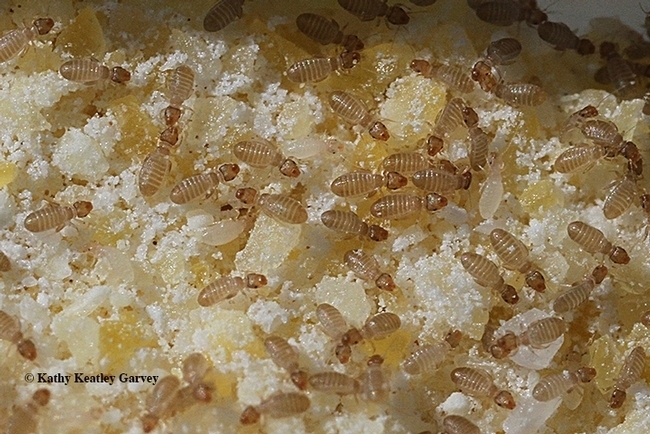
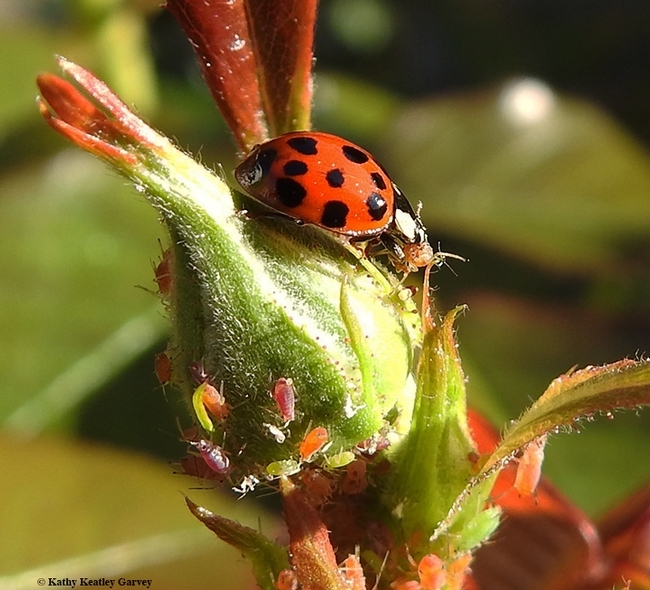
- Author: Kathy Keatley Garvey
Monarch butterflies aren't the only insects that like milkweed.
Honey bees, lady beetles and aphids, do, too.
We found all three insects, plus a monarch butterfly, on our scarlet milkweed (Asclepias curassavica) today (Labor Day). Most of the insects were oleander aphids, which attract lady beetles. aka ladybugs.
Asclepias curassavica, also known as tropical milkweed, and Mexican butterfly weed, is native to South America but is frequently planted throughout the United States to attract monarchs. In the United States, you'll find it not only in California and Florida, but in Hawaii, Louisiana, Tennessee and Texas, among others states. The colorful plant is known by some as "redhead," due to its brilliant red (and yellow) flowers.
Unfortunately, some of the "yellow" is a pest that needs to be eradicated. See the UC Statewide Integrated Pest Management Program (UC IPM) guideline on aphids.
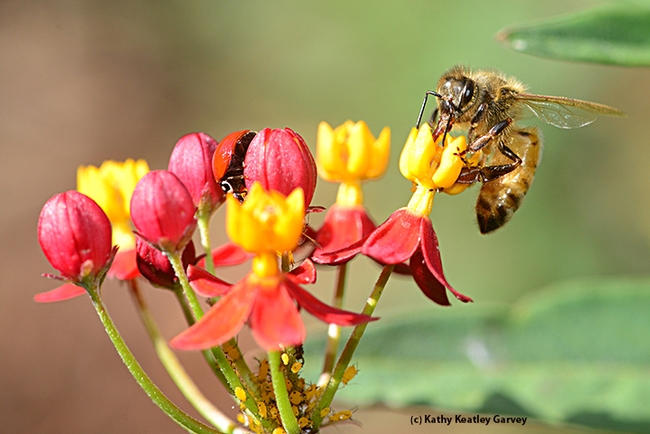

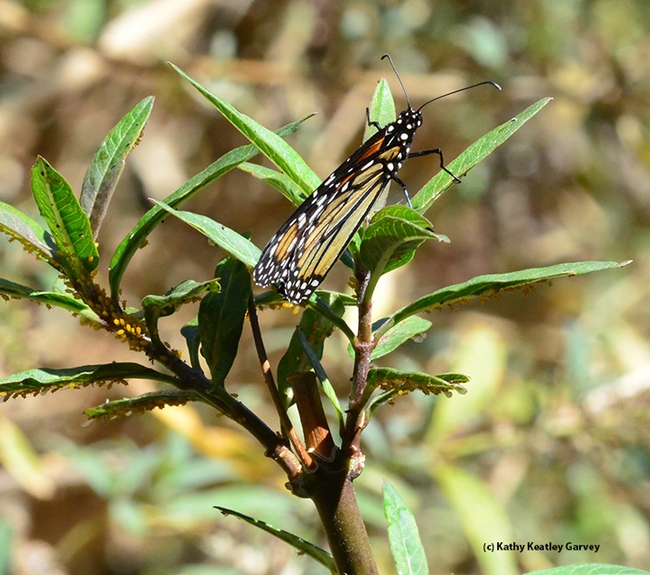
- Author: Kathy Keatley Garvey
Sometimes in a world of towering skyscrapers, jumbo jets and warehouses big enough to hold a small planet--or at least a state the size of Rhode Island--we don't realize how “small” small is.
Last weekend it was a veritable insect feast on our narrowleafed milkweed. We saw lady beetles feeding on the oleander aphids, the oleander aphids sucking the very life out of the plant (plant juices) and monarch caterpillars polishing off the leaves.
Then the aphids started crawling on the ‘cats, and a whole new perspective of "small" burst into view.
An aphid, at about 1.5mm, is just a little larger than a pinhead. The lady beetle ranges from 0.3 to 0.4 inches (8 to 10 mm), while the monarch caterpillar, depending on the instar, is absolutely huge in comparison. Spell that H.U.G.E. According to MonarchWatch.org, the 1st instar is 2-6mm; 2nd instar, 6-9mm; 3rd instar, 10-14mm; 4th instar, 13-25mm; and 5th instar, 25-45mm.
With two handheld cameras (a Nikon D800 with a 105 macro lens and a Canon EOS 7D with an MPE 65mm lens), we managed to grab a few photos of a tiny aphid crawling on the caterpillar's head, body and tentacle.
That's how "small" small is.




- Author: Kathy Keatley Garvey
Think of them as "the good guys" and "the good girls."
Insects such as lacewings, lady beetles and flower flies.
We're delighted to see that the Xerces Society for Invertebrate Conservation has just published a 250-page book on "Farming with Native Beneficial Insects."
The book advocates the use of beneficial insects to prey upon crop pests, thus "reducing or eliminating the use of pesticides," say co-authors Eric Lee-Mäder, Jennifer Hopwood, Mace Vaughan, Scott Hoffman Black, and Lora Morandin.
"This comprehensive guide describes how to recognize these insects and their habitat, and how to evaluate, design, and improve habitat for them," they write. They offer specific solutions, including native plant field borders, mass insectary plantings, hedgerows, cover crops, buffer strips, beetle banks, and brush piles.
The much-acclaimed book, available for purchase on the Xerces website, is drawing well deserved accolades, including this one from Claire Kremen, professor and co-director of the Berkeley Food Institute, University of California, Berkeley:
“If you are a grower or a backyard gardener, this is a ‘must have.' Readable and filled with gorgeous photos and handy charts, this book provides reams of information about how to get the upper hand on your pest issues with reduced or no pesticide use.”
Xerces officials say the release of Farming with Native Beneficial Insects coincides with its launch of a new nationwide workshop series on natural pest control: the Conservation Biological Control Short Course. The course, to begin in the West and Midwest, "provides farmers, crop consultants, and government farm agency staff with a comprehensive, hands-on training in the natural pest management strategies described in the book. A similar workshop model previously offered by Xerces trained tens of thousands of people in farm communities across the U.S. to conserve bees and restore pollinator habitat, and helped facilitate the restoration of more than 100,000 acres of wildflower habitat for bees."
Speaking of "the good guys" and "the good girls," be sure to read the UC Statewide Integrated Pest Management Project's website on beneficial insects and natural enemies. The natural enemies include assassin bugs, bigeyed bugs, brown lacewings, convergent lady beetles, damsel bugs, dustywings, syrphid flies and twicestabbed lady beetles.
What is Integrated Pest Management (IPM)? "Integrated pest management uses environmentally sound, yet effective, ways to keep pests from annoying you or damaging plants. IPM programs usually combine several pest control methods for long-term prevention and management of pest problems without harming you, your family, or the environment. Successful IPM begins with correct identification of the pest. Only then can you select the appropriate IPM methods and materials."
UC IPM points out:
- Many pests can be managed without the use of pesticides.
- Use pesticides only if nonchemical controls are ineffective and pests are reaching intolerable levels.
- Use pesticides in combination with the methods described above.
- Choose pesticides carefully. Use the least toxic, most effective material to protect human health and the environment.
- Examples of least toxic insecticides include:
- Soaps;
- Oils; and
- Microbials such as Bacillus thuringiensis (Bt) and spinosad.
The more we learn about pests and the natural enemies of pests, the oft-heard quote, "Keep your friends close and your enemies closer" rings quite true. The more we learn about our enemies, the less likely they will be able to harm us.



- Author: Kathy Keatley Garvey
Some folks like to watch the grass grow, flowers bloom, or clouds drift.
Others just like to sit back and look for insects.
We spotted this seven-spotted lady beetle (aka ladybug) last Monday morning in the Häagen-Dazs Honey Bee Haven, a half-acre pollinator garden on Bee Biology Road at the University of California, Davis.
It's a predator, a beneficial insect, and an icon. As one of the most recognizable of all insects, it inspires clothing, art and jewelry themes; home décor; and video games, not to mention all things entomological and the citizen-scientist Lost Ladybug Project. It even prompted five states--Delaware, Massachusetts, New Hampshire, Ohio, and Tennessee--to declare it their official state insect. Never mind if these states are, in the political sense of the word, red or blue, denoting Republicans or Democrats. When it comes to state insects, they're all red!
Lady beetles are especially known for their voracious appetite for aphids, scale insects, mealybugs, mites and other soft-bodied insects. A gardener's friend. A biocontrol dream. An aphid's nightmare.
It's easy to see why the seven-spotted lady beetle, Coccinella septempunctata, is so named. Seven large black spots dot its red wing covers or elytra.
Indeed, if you know Latin, you know that its scientific name, septempunctata, means seven (septem) and spot (punctus).
We watched our seven-spotted friend prowl for aphids on a color-coordinated California fuchsia (Zauschneria californica mexicana).
It was "walking the line," Johnny Cash-style, keeping a close watch on...tasty aphids.

